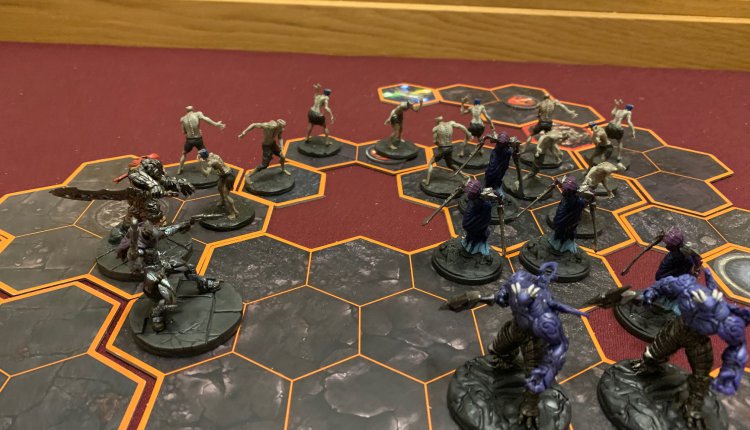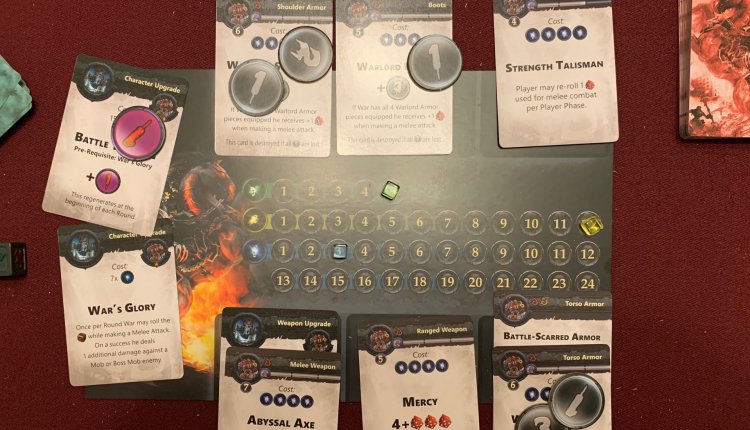Darksiders: The Forbidden Land — The Horsemen Ride Again!
Into the Forbidden Land rode the Four Horsemen...
A limited-edition board game based on a video game? Darksiders: The Forbidden Land, you know me well!
In recent years, board games and video games have shared a larger and larger intersection in the Venn diagram that is entertainment. I for one haven’t minded this in the slightest, as new ways to experience the franchises I enjoy are often a good thing, and the likes of Gears of War, XCOM, and Bloodborne have transitioned well from the screen to the table. Recently, Darksiders: Genesis was released on all major platforms, and the limited Nephelim edition of the game came with a spin-off board game in the shape of Darksiders: The Forbidden Land. Being as this special edition is the only way to acquire this board game from a series I’m a fan of, I snapped it up.
Darksiders: The Forbidden Land is a one to four player, narrative co-op game with a core focus on grid movement and hand management. Across seven chapters, you and up to three allies will take on the roles of the Four Horsemen (or Riders) of the Apocalypse — War, Death, Fury, and Strife — as they venture into the titular Forbidden Land to discover why it is suddenly accessible and what secrets lie within. If you are familiar with the Darksiders franchise, you’ll have an idea of what to expect in broad terms. Demons, monsters, and other diabolical threats will seek to impede your Riders in large numbers, whilst you use your powerful abilities to slay them and absorb their energy to power your skills and heal your wounds. Of course, this being a board game rather than a video game means this is done in quite a different way.
During the player turn you play cards to move, attack, or use an ability printed on it, often in exchange for Energy or Wrath, your two main resources. This can be done in any order to allow players to synergise as best they can. Once everyone is done, the creature phase begins, in which cards are drawn from the AI deck to determine how far enemies move, how many spawn, and if any special events occur. Opponents that get within melee range will automatically damage any Rider before players redraw their hand of cards and a round begins again. Should all the riders fall, or specific fail conditions are met, it’s game over. If all the enemies and their spawn points are destroyed, or victory conditions are met, then victory is yours!

As well as abilities, your character’s deck includes items that you can equip to increase your armour and unlock additional skills. Should these items be destroyed by enemy attacks then they are removed from the game and added to Vulgrim’s Shop where you can buy them back and return them to your deck if you visit him during a mission — easier said than done. Weapons can also be equipped to increase your chances of defeating enemies. Combat works in a very similar way to Zombicide, with attacks using a number of dice, with each one exceeding a target causing a point of damage. Most enemies have to be killed outright rather than damaged over multiple turns. You’ll need to use your skills with care to ensure you maximise the damage on a single strike.
There are additional challenges along the way, including escort quests, bosses to fight, and secret doors to open, but the core mechanics stay fairly similar. You’ll find that your character develops over the course of the chapters — each one lasting a couple of hours — as they gain equipment and buy permanent upgrades from Vulgrim. Each character feels wonderfully unique too, with War being able to cause huge damage to multiple enemies up close, whilst Death can control foes to fight for him. Further to this, you have two different decks for each Rider as well as the option to build your own deck using a points system. There really are plenty of ways to play Darksiders: The Forbidden Land to keep it interesting for you.
The game itself is really quite enjoyable to play. Turns are often quite quick even though you have a number of options available. Enemy turns are fairly easy and quick to resolve, although large spawn can result in a lot of minis to move around the board. Your character feels powerful against fodder opponents, whilst you really need to be more careful against the larger threats.

That isn’t to say there aren’t any problems though. The rule book is not brilliantly written and seems to be in a less-than intuitive order. When checking rules during our early games, I found myself having to flit through various pages to put together the information I needed. The player reference cards did help here somewhat. The hex-based modular board is great for minimising the amount of stuff you need to pack up, but it does make setup for a level take a fair while. It has a large footprint too, so you’ll need a fair bit of space to play some of the larger stages.
Most irritating though is the heavy reliance on dice for attacking, but there being no way to mitigate damage when attacked. If an enemy ends its movement next to your rider, you will take damage. If you miss an attack roll and then find yourself surrounded after creature movement then you’ll take massive damage, with a fair chance of death. Thankfully, the designers have issued a new rule on their website that included Active Defence, allowing you to set aside cards on your turn to use for defence during the enemy’s. This is a nice post-release addition, but without checking up on this then there’s no way of being aware.
There have also been issues with the number of enemies spawning. Some rounds have had as many enemies spawn as we’ve just defeated, sometimes leading to round after round of stalemate as you take out enemies only for them to be immediately replaced. It’s not a huge problem as it will likely be resolved with some good card draws, but it can slow down the otherwise good pace.

Now, one of the things that really caught my attention with Darksiders: The Forbidden Land was the components. The cards are of good stock, and the tokens are all nice and chunky cardboard, the player boards are a bit flimsier than I’d like though. The minis are excellent quality in terms of detail though, and the fact they are pre-painted is a real treat for someone with no artistic talent such as myself. Whilst the paintwork isn’t perfect — Fury and War have a few blemishes — the vast majority look really good, and add a lot to the game.
As an overall package, Darksiders: The Forbidden Land is a very good board game. There’s plenty of content there for up to four players, plus a fifth if someone wants to play the demons. The manual does mention player-created chapters online, but there don’t appear to be any available yet which is a shame. Having a modular board does allow you to create your own scenarios even without this though. I’m looking forward to finishing up the campaign and trying out some homebrew levels using the other Riders soon. A solid game to add to the video game/board game crossover collection!
You can find Darksiders: The Forbidden Land on Amazon.
Love both video games and board games? Here’s our list of some fantastic crossover games.
Comments are closed.